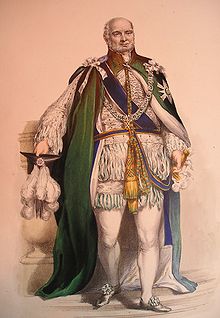
Prince Augustus Frederick was the sixth son and ninth child of King George III and Queen Charlotte. He was born at Buckingham House on 27 January 1773. He was initially tutored at home. However, in 1785, along with his brothers, Ernest, Duke of Cumberland, and Adolphus, Duke of Cambridge, he studied at Göttingen University in Germany.
Because of what was known, at the time, as “convulsive asthma,” he did not pursue an army or navy career. Reportedly, he briefly considered becoming a cleric in the Church of England. In 1805, during the Napoleonic War, he served at home in Britain as Lieutenant-Colonel Commandant of the “Loyal North Britons” Volunteers regiment.
Augustus supposedly had a great passion for music and literature, especially the classics, so he spent some time in Europe pursuing his studies. It is said that he had a library of some 50,000 volumes, including some 5,000 copies of the Bible. While studying in Rome, he met his first wife, Lady Augusta. Augusta was the second daughter of John Murray, 4th Earl of Dunmore and Lady Charlotte Stewart. She was 5 years older than Augustus. People claim she was very “plain” of countenance and had the tendency to be as “bossy” as her mother.
Without his father’s permission, Augustus secretly married Lady Augusta in Rome on 4 April 1793 in an Anglican ceremony conducted by the Reverend Gunn. The King’s minister of Hanover affairs, Ernst zu Münster, was sent to Italy to escort Augustus back to London. [Henderson, T.F. (2004). “Augustus Frederick, Prince, Duke of Sussex (1773–1843)”. Oxford Dictionary of National Biography. rev. John Van der Kiste. Oxford University Press.]
The couple married again without revealing their full identities at St George’s, Hanover Square, Westminster, on 5 December 1793. Both marriages took place without the consent, or even the knowledge, of his father, meaning they were in contravention of the Royal Marriages Act of 1772.
Angered by his son’s ignoring his wishes, George III had the marriage declared null and void by the Court of Arches on 3 August 1794. However, Prince Augustus Frederick continued to live with Lady Augusta until 1801, when he received a parliamentary grant of £12,000 and the couple separated. Lady Augusta retained custody of their children and received maintenance of £4,000 a year. Their two children were named Sir Augustus Frederick d’Este (1794-1848) and Augusta Emma d’Este (1801-1855), both parents being descended from the royal House of Este. In 1806, their mother, Lady Augusta, was given royal licence to use the surname “de Ameland” instead of Murray. [The London Gazette. 18 October 1806. p. 1364] She was then styled as “Countess” She died at Ramsgate in 1830.
Sir Augustus Frederick d’Este became Deputy Ranger of St. James’s and Hyde Park. He made an unsuccessful attempt to claim the dukedom (Duke of Sussex) upon his father’s death. Meanwhile, his sister, Augusta Emma d’Este, married Thomas Wilde, 1st Baron Truro. Truro became Lord High Chancellor from 1850-1852. Neither of the Prince’s children produced children of their own.
A year after the death of Lady Augusta D’Ameland (Lady Augusta Murray), the Duke of Sussex married a second time on 2 May 1831. This marriage occurred again in contravention of the Royal Marriages Act. He married Lady Cecilia Letitia Buggin (1793–1873), the eldest daughter of Arthur Gore, 2nd Earl of Arran, and Elizabeth Underwood. She was the widow of Sir George Buggin. She was 12 years Augustus’s junior. They had no children from the marriage. On the same day, Lady Cecilia assumed the surname Underwood by Royal Licence. She was never titled or recognized as the Duchess of Sussex. However, she was created Duchess of Inverness in her own right by Queen Victoria in 1840.
Lady Cecilia was popular in society, and Prince Augustus was known as a great patron of the arts and of science. At Queen Victoria’s wedding to Prince Albert in 1840, Augustus gave her away at the wedding ceremony.
Augustus died of erysipelas on 21 April 1843. He was buried at Kensal Green Cemetery, a little north of Paddington. As Lady Cecilia could not be buried with him in the royal vault, Augustus chose Kensal Green instead. Lady Cecilia died at Kensington Palace on 1 August 1873.




Greetings. Excellent post! I think that you may like this – not Prince Augustus Frederick, but Prince Frederick Augustus (1763-1827). https://dinosaursandbarbarians.com/2015/05/30/prince-frederick-augustus/.
Thanks for sharing this with me. The are so many “Augustus” and “Augusta” names used sometimes my head begins to spin.
The fact that I mostly study ancient history doesn’t make things any easier!